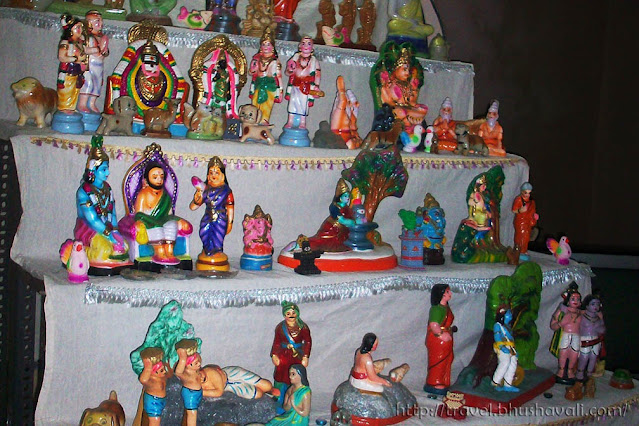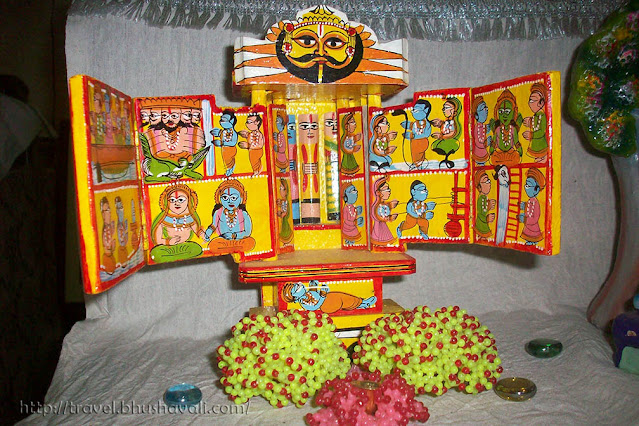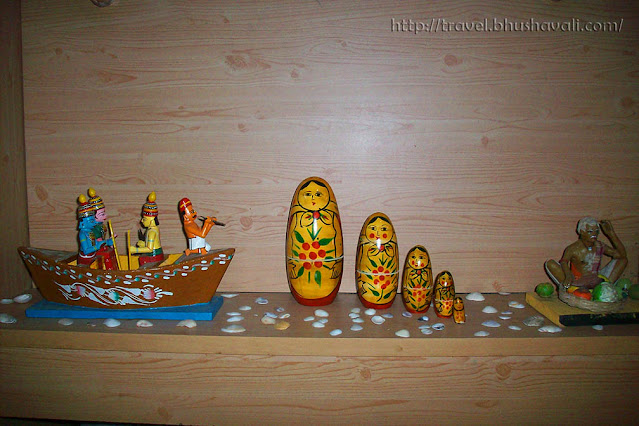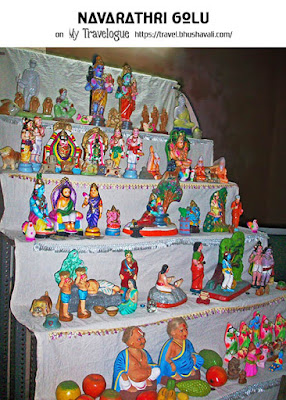Navarathri is more special for me than other important festivals like Diwali or Pongal (Makara Sankranthi) as I get to do a lot during Navarathri esp. arranging the Navarathri Golu. Kolu (or Bommai Golu) is the arrangement of dolls and several figurines in steps that may be 3,5,7,9 or 11 in number. This is primarily celebrated in Tamil Nadu, Andhra Pradesh & Karnataka
WHAT IS NAVARATHRI?
Navarathri means 9 nights. It is the celebration of the Trinity Goddesses – Parvathy, Lakshmi and Saraswathi. It ends with Dusshera aka Saraswathi Puja and Vijayadasami. In the northern states of India esp. Gujarat it’s more of a Dance and Music festival with Dandiya Raas, Garbha Dance etc. But in southern states it’s a décor and music festival. It’s been an incredible experience always. Arranging the Golu, inviting people to visit the Golu, dressing up kids as Lord Krishna and Gopika, sharing ‘sundal’- a preparation of legumes like green peas – a specialty snack of Navarathri, singing the classical Carnatic songs, its all such a great festival. It requires lots of patience and passion as well to unpack the dolls, fix the steps, arrange the dolls, entertain the guests for the whole 9 days, repack the dolls and store them properly to prevent breakage, because most are terracotta dolls.
When my mom started keeping Golu when I was a kid we started with 3 steps, that too managed with trunk boxes and tables etc. Then we proceeded to 5 steps and then as we collected several dolls we bought the Kolu stand and here is our Kolu with 7 steps plus a few arrangements on the side. Though Golu dolls online shopping can be done, visiting the artisans, touching & feeling the bommai is a special thing. But golu steps online purchase is a good idea though!
SIGNIFICANCE BEHIND NAVARATRI KOLU
Our culture is more oriented towards story telling and art based passing-on of information. That's why a lot of temple sculptures, paintings etc than documents or books. The Golu is to tell the stories of our Gods to kids by narrating with dolls. (Something typical we do till date with any toys or dolls - enacting Barbie & Ken's wedding with dolls or race car driving by pushing Hotwheels cars). Why village scenes? Again story telling - talking about farming, marriage, buying groceries (Chettiar bommai), stories & legends of Gods and finally stand-alone sculptures of Gods themselves for praying.
DO EVERY SOUTH INDIAN FAMILY ARRANGE DOLLS ON NAVARATRI?
Do every south Indian household celebrate navaratri by arranging dolls? No. So why do some people keep Kolu and some don't? Being a traditional festival, its basis is on caste system. Stories of Gods was important only to people whose caste had their occupation associated with God. The castes associated with war or business weren't doing this. Obviously it's a thing of past and now whoever can do it does it because it's fun to do it but it's a too much work also! Which would also explain that dolls of cricket & musical troupe is all a very modern addition.
WHY IS NAVARATHRI KOLU ARRANGED IN STEPS? WHICH STEP HAS WHICH DOLLS?
It's Navaratri (nava + rathri) which leads to Vijayadasami (Dusshera), like steps to reach something. What sculptures in which step? Again story telling. You talk about everyday life in lower steps and move on to magical stories of Gods in middle steps and just sculptures of Gods for prayer in the top steps. Number of steps is just decided by the number of dolls they have and the height of the house itself!
IS NAVARATRI A WOMEN'S FESTIVAL?
Yes. Each festival is dedicated to a particular God. Krishna Jayanthi, Hanumath Jayanthi, Diwali for Krishna (south)/Rama (north). Likewise, Navaratri is meant for all female deities - Lakshmi, Saraswati, Parvati & all their reincarnations.
MY NAVARATHRI BOMMAI GOLU DOLLS / BOMMALA KOLUVU
Let me show you it all step by step. Starting from the first step. The first step generally has figurines of Gods and Goddesses. At the centre is Lord Shiva holding Lord Ganesha aka Pillaiyaar and beside him is his consort Goddess Parwathi holding Lord Murugan aka Karthikeyan. A typical family picture! Beside them is Lord Buddha and then a breastfeeding mother (who I choose to place along with the Gods). To the other side are Gandhiji with his 3 monkeys and Lord Rama, Sita and Lakshmana. The 3 monkeys denote see no evil, hear no evil and speak no evil as Gandhiji instructions.
On the third step are 3 different scenes. The first scene is Lord Krishna with his wife Rukmini and childhood friend Kuselan. Kuselan aka Sudama is a father of 27 kids who is highly affected by poverty. Well, what would you expect out of a guy who has 27 kids.!!! Since Krishna is a king, he decides to ask help. So as a gift he takes beaten rice. As Krishna takes one handful of rice, the whole of his gold goes to Sudama’s place. On the second handful, Kuselan’s house becomes a palace. In the front as you may see there are some little figurines. The beadwork of the Sivalingam with the snake and a Thulasi Madam between second and third scenes were again among my mom’s 9th grade work! The 2nd scene is Kamakshi hugging Siva Lingam. She had actually made this Lingam with sand beside a river in Kanchipuram and started praying him to accept her as his wife. When the river started bulging with overflowing water, the lingam was at the verge of dissolving when she just hugged it that it doesn’t dissolve. With her love and warm hug, Lord Shiva accepted her and married her. The third scene is Avvaiyum Navarkaniyum. Avvai is an old lady poet who was proud of her knowledge. So Lord Muruga in the form of a little cowboy sits atop a Naval Maram – Jamun tree. When Avvai asks this cowboy to pluck and put down some Jamun Fruits, he asks ‘Sutta Pazham Venduma.? Sudadha Pazham Venduma.?’ (Do you want cooked, hot Jamuns or normal Jamuns). She laughs and says, ‘How do u cook Jamun’. He says, ‘Its possible’. She says, ‘Ok. Give me Sutta Pazham. He plucks and throws the fruits down. She picks them up and blows the sand stuck onto it. On seeing this, he asks, ‘Seems the Jamun really hot, you are blowing it.?’. Immediately she realized, this is God himself!!!
Now comes the 5th step. This step has 2 scenes. First is Thanjavur Thalaiyatti bommai of Chettiar and Chettichi. Chettiar is the merchant community of South India. So here is a couple selling fruits. The second scene is Raas Leela. The lover God Krishna is an incarnation of Lord Vishnu. He is seen here with several Gopi’s.
The next step has a Rajasthani Kaavad. Its from a place called Bassi in Rajasthan and its like a portable temple! Its handmade with wood and handpainted on it! This is carried by religious story tellers from village to village and they explain the story depicted in each section opening door by door! See the beaded flowers in front? Those were done by my mom when she was a school child in her 9th grade. Next is Bharatha Pillayar. It is believed that Lord Ganesha aka Pillaiyar, wrote the Mahabaratha, one of the longest epics in India along with Ramayana, as said by Maharishi Vyasa. So in the scene is depicted the same.K. Now lemme continue. Where did I leave last time? Ya. The fourth step.
On the 7th step is the elaborate scene of ‘Kanchipuram Garuda Sevai’. It’s an elaborate procession in the Varadaraja Perumal Temple in Kanchipuram. Garudan – Eagle is the Vahana – Mount of Perumal – Lord Vishnu. This procession is a speciality for the Garudan. So the Garudan is seen really bigger than Lord Vishnu himself.
OTHER NAVARATRI DOLLS BESIDE GOLU STAND AT MY HOME:
Well, now that all the 7 steps are completed, lets move on to the side displays. Golu ideas for side displays vary so much from utilizing the entire floor to make extensive models.
On the other side, is another side display that has several assorted dolls. The Taj, the slipper and the heart are my handwork in Papier Mache which I did a few years back. The 3 Baby Dolls behind those are from Japan. Japan too has a similar festival called the Doll Festival for Girls – Hina Matsuri. A snake and a crocodile need a special mention. These are African Wooden Wiggle Snake Art. This is done by attaching little pieces of wood to a piece of leather centrally placed. As you may see the whole croc and the snake can twist and turn almost like a real snake. The flexibility is so really amazing.















புத்தர்
ReplyDeleteசெட்டியார் ஜோடி
நந்தி
ராமர் சீதை லஷ்மணன் படகு பயண பொம்மைகளை பார்க்கையில் எங்க வீட்டு கொலு ஞாபகம் வந்தது! இதெல்லாம் எங்க வீட்லயும் இருக்கே!
நவராத்திரி கொலு அந்த வாரம் புல்லா செம சந்தோஷமாக இருந்த தருணங்கள் :)
I have never visited a GOLU before bot have got some idea as what it is :)
ReplyDeletenice post yaar :)
gr8 blog pa :)
u have a new follower :)
keep blogging
cheers!!!!
So colorful all
ReplyDeleteI love it,
Amazing post !!!
They are so nice and colorful !!!
ReplyDelete@Ayilyan,
ReplyDeleteThanks a lot. :) Glad to know I could kindle back your sweet memories... :)
@Sathish,
Wow... Great to know I introduced Kolu to you. Thanks a lot for dropping by and commenting. Thanks a ton for following. Do drop in often. Would love your visits n comments.. :)
@Anya,
Thanks sweety.. :)
@Emarald,
Thanks for dropping by and commenting. :)
Do drop in often. Would love your visits, comments & followups.. :)
ஒரு கொலு பொம்மையே
ReplyDeleteகொலுவை பத்தி எழுதுதே..
அடடே..
ஆச்சர்யக் குறி.. :))
Very interesting to learn these traditions as exhibited through the doll scenes.
ReplyDeleteReally nice collections and nice narrative. Mysore also had a tradition of keeping dolls and such figurines during Dasara when I was growing up as a kid. I am not sure if the tradition is still as prevalent as it was back then. Lovely to see that this is alive and well in your place. All the best for this very auspicious period.
ReplyDeleteHello Mitr-friend, thank you for visiting.
ReplyDeleteIt looks like you have a lot of festivals. I think it is nice to be in a festive mood often. It keeps us busy :)
great golu! loved the rama tableau in the boat! have never seen that one!
ReplyDeleteSo interesting these traditional dolls!
ReplyDeleteWhat an elaborate description of an equally elaborate arrangement based on mythological stories.
ReplyDeleteThat goes on to prove how diverse and massive our heritage and culture is. You always end up knowing something that we never heard or read before.
Great post!
And thanks for visiting my blog.
Very interesting post. Your culture has great festivals and intriguing stories.
ReplyDelete@Sanjai,
ReplyDeleteEnna Nakkala..!!! Anyways, Happy Navarathri.. :)
@Janie,
Thanks a lot dear.. :)
@Anup,
Of course, the whole of South India has the tradition. It is still prevalent in many of the places. Thanks a lot dear. :) Happy Navarathri.. :)
@Ocean Girl,
That's true dear. We have so many Gods n Goddesses and special celebrations for each and everyone of them. It's a celebration almost atleast once every month.
@Anu,
Thanks dear. :) Glad that I introduced a new scene to you. :)
@Phivos,
Thanks dear. :)
@Sumandeb,
Very true. Our own culture astonishes me many a times.. :) Thanks for dropping by. Do drop in often. Would love your visits, comments and followups. :) And, Happy Navarathri. :)
@Diane,
Thanks sweety.. :)
These little statues are beautiful. So intricate and so much colour. To me this offers an insight into quiet unknown traditions.
ReplyDeleteThank you for your always lovely comments at my place.;)
Nice photos.The details for the dolls are interesting.
ReplyDeleteHi Mi-Friend! Another week has passed without a chance to drop by. It seems time runs faster when you get to a certain age... ;)
ReplyDeleteInteresting post! The things that I learn when I get here!!
Blogtrotter is trying to have fun in the Turkish Riviera. Enjoy and have a marvellous weekend!
@ Protege,
ReplyDeleteThank you so much dear.. :) And ur welcome dear.. :)
@Mojo,
Thank you.. :)
@GMG,
Don't say so GMG, you are an ever young person. :) Thanks a lot for your kind comments. :)
This is a terrific post. I love the step-by-step description of your kolu. It brought back so many fond memories of kolus past, when we kept kolu at home and visited homes far and near.
ReplyDeletethozhhi kalakitinga.. the one tat i luved was the narration about each step.. realy wonderful
ReplyDelete@Work Hard,
ReplyDeleteThanks dear.. :)
@Kamini,
Thanks a lot sweety. Glad that I could kindle those sweet memories.
@LK,
Thanks thala... :)
lovely pics!!! and wonderful dolls! loved this closer look at them! and that bead tulsi madam reminded me of one we had.. made by my grandmother... its with my uncle now!
ReplyDelete@Anu,
ReplyDeleteThanks dear.
U too have a Tulasi Madam, made by your granny??? Wow, that's so heartening. Its indeed sad that the schooling these days have become so stereotyped and such crafts are just not given importance. My mom made these as a part of her school curricullum...